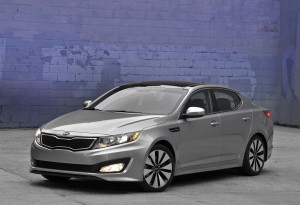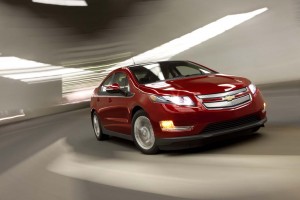
Fuel economy has been rising sharply as buyers opt for smaller vehicles and downsized powertrains - like the I-4 offerings in the 2012 Kia Optima.
For the second straight month, the fuel economy of the typical new vehicle sold in the United States has risen to an all-time record, according to research by the University of Michigan Transportation Research Institute.
The average fuel economy of cars, light trucks, minivans and SUVs purchased in February was 23.7 miles per gallon, up from 23.5 in January, which was revised upward from the 23.0 mpg initially reported last month.
But even while fuel prices have been soaring, U.S. motorists have largely steered clear of the most fuel-efficient vehicles on the market, a new generation of battery-electric vehicles, or BEVs, and plug-in hybrids – some of which have been given ratings approaching 100 MPGe, or miles per gallon equivalent, by the EPA.
Michael Sivak, research professor and head of UMTRI’s Human Factors Group, estimated the average fuel economy of all new vehicles bought last month was up 5% (1.1 mpg) from just two months ago and is now 16% higher 3.3 mpg than four years ago in February 2008.
TrueCar.com, which tracks new car pricing, trends and sales, reported actual fuel economy numbers from February light-vehicle sales – what it calls the TrueMPGTM — increased to 23.2 mpg in February 2012 compared to 22.9 mpg in January 2012 and 21.4 mpg in February 2011.
“The American consumer shopping for a new car is seeing the most fuel-efficient lineup of vehicles ever while manufacturers are keeping the product just as exciting,” said Jesse Toprak, Vice President of Market Intelligence at TrueCar.com. “Ford’s average fuel economy increased by almost 5 MPG, which is quite staggering and much of the credit goes to the Fusion and Focus, along with its new lineup of six-cylinder large trucks.”
Significantly, Ford has announced plans to end production of the hybrid version of its Escape SUV, which is being redesigned for 2013. With only a few exceptions, sales of conventional gas-electric models have lagged at barely 2% of the overall market even as fuel prices have skyrocketed. And about half of all hybrid sales have been accounted for by one model: the Toyota Prius.
Meanwhile, Prius sales have been running about 10 times higher than demand for all of the more advanced BEVs and plug-ins combined, according to industry data. Plagued by an over-supply on dealer lots, General Motors will shut down production of its Chevrolet Volt, starting next Monday, for five weeks.
A second wave of battery-based vehicles will begin hitting market in the months ahead, ranging from Ford’s plug-in hybrid C-Max Energi to the battery-powered Toyota RAV4-EV. But industry analysts have begun questioning whether any of those models will hit sales targets unless fuel prices surge even higher – perhaps the $5.00 a gallon range some forecasts are now calling for later this year.
But for now, many buyers are simply opting to downsize their powertrain choices, if not their vehicle itself. V-6 engines now routinely outsell V-8s in Ford’s big F-150 pickups. And V-6 options are rapidly vanishing in the midsize segment. Both Kia and Hyundai, for example, now offer various inline-four packages only in their midsize lines, the Optima and Sonata, respectively. Meanwhile, the small car segment grew to 23% of the overall U.S. market in February, according to a report by Edmunds.com, up from 17.9% as recently as December.
In addition to tracking average fuel economy, Sivak and UMTRI colleague Brandon Schoettle issued the monthly update of their national Eco-Driving Index, which estimates the average monthly emissions generated by an individual U.S. driver. The EDI takes into account both vehicle fuel economy and distance driven—the latter relying on data that are published with a two-month lag.
During December 2011, the EDI stood at 0.87, up from a revised value of 0.84 in both October and November. The index currently shows that emissions of greenhouse gases per driver of newly purchased vehicles are down 13%, overall, since October 2007 (the first month of the index).
Paul A. Eisenstein contributed to this report.

